The winner – Mailchimp
Life-changing superhero
In this comparison, Mailchimp wins eight out of ten rounds. There is only one round that ends in a tie and one ending in favor of Campaign Monitor. Carry on reading to learn how these two platforms compare with each other.
What Mailchimp features are better than Campaign Monitor?
- Landing page builder and analytics
- Email campaign analytics
- Marketing automation
- Greater flexibility and a wide range of segmentation options
- There are neither landing pages nor signup form analytics
- Pretty basic email campaign reports
- Pretty basic marketing automation
- Pretty basic segmentation
Among the vast array of email marketing platforms available, two prominent names stand out: Mailchimp and Campaign Monitor.
With their robust features, competitive pricing models, and dedicated customer support, these platforms have earned the trust of countless businesses worldwide.
But regarding Campaign Monitor vs Mailchimp, which is the right tool for your business?
Mailchimp holds a significant market share in the email marketing industry and for good reason. It has a huge arsenal of features, enabling users to meet most of their marketing needs.
Campaign Monitor is also a powerful email marketing tool in its own right. It is praised for its ease of use, simple navigation, and real-time reporting analytics.
In this article, we’ll review and compare both tools in depth and help you make an informed decision for your business.
Campaign Monitor vs Mailchimp: Quick overview
Mailchimp is inarguably one of the best email marketing tools, with a Shopify App Store rating of 3.6 out of 5. Known for its fun branding and advanced features, the tool offers much to be excited about, even if you only have a free plan.
Campaign Monitor, on the other hand, is best known for its simplicity. With it, you can create professional-looking emails in seconds and improve engagement with subscribers.
So which one should you pick — Campaign Monitor or Mailchimp?
This article will help you decide.
To start off, we’ll provide you with an overview of the key differences between these tools, followed by an in-depth feature-by-feature comparison of Campaign Monitor and Mailchimp.
Let’s dive right into it.
As you can see, Campaign Monitor comes with fewer features than Mailchimp. It offers no robust analytics or automation. The following section compares the two platforms’ tools and capabilities in detail.
Campaign Monitor vs Mailchimp comparison: Feature by feature
Whether you choose Campaign Monitor or Mailchimp, your email marketing ROI will likely grow.
But there’s a high chance you’ll benefit more from one of the two tools. Find out which one that is.
Ease of getting started
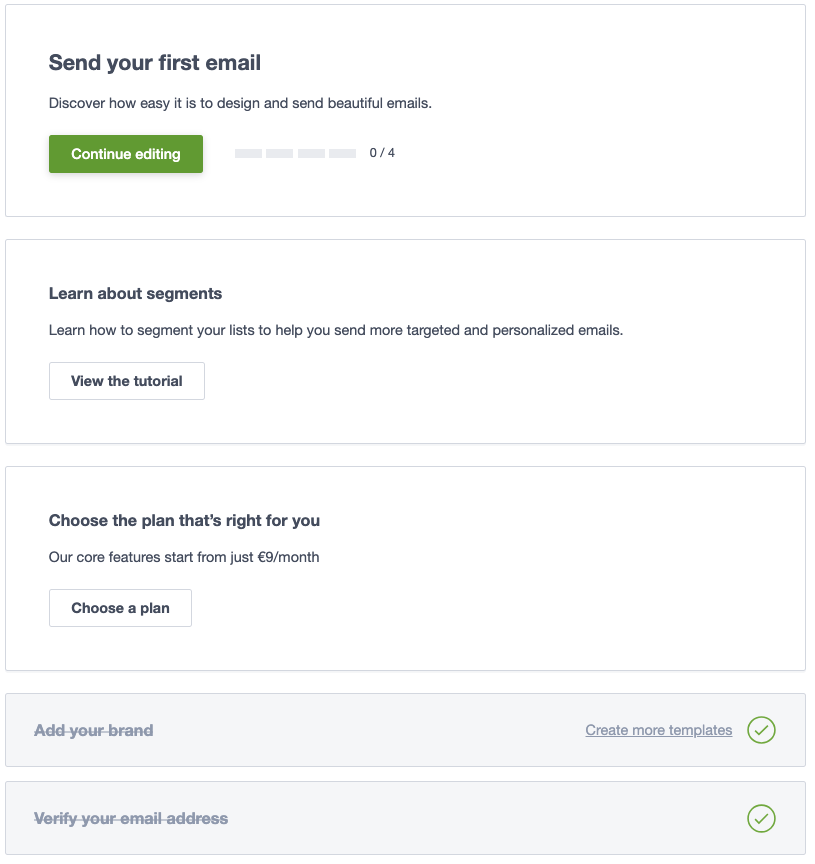
With both tools getting started is pretty seamless. Campaign Monitor’s free trial and Mailchimp’s free plan don’t require credit card information.
But if you’re signing up for Mailchimp’s free trial, you must share payment information.
Creating an account on both tools only requires essential information such as:
- Your name
- Email address
- Organization name
- Website URL
In terms of navigation, both Campaign Monitor and Mailchimp present a clean and intuitive interface.
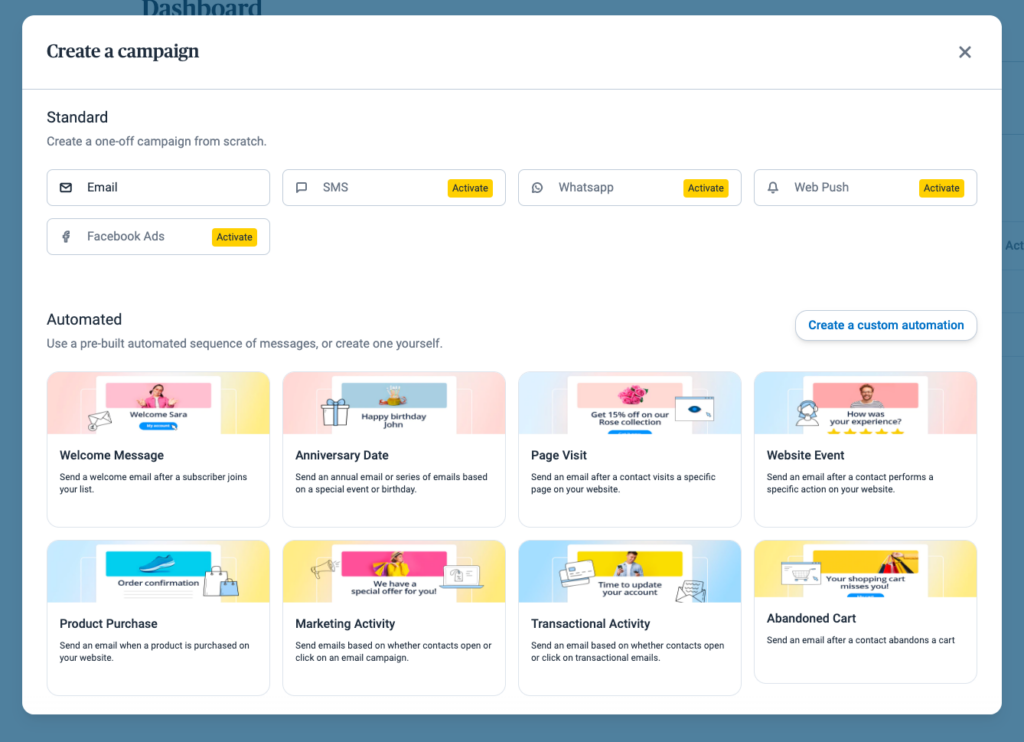
Does that mean Campaign Monitor and Mailchimp are equally user-friendly?
No. Although the first impression is good, Campaign Monitor disappoints a little when you start looking for standard functions such as creating segments or signup forms. We didn’t manage to find those functions as easily as they should be.
Mailchimp is also fraught with issues on this front. Due to its extensive array of features, locating specific functions is challenging. For instance, altering the sender’s email address or removing the branding may be slightly complex.
The good thing? Mailchimp has a checklist on what to set up to get your account ready, which is very helpful for beginners.
The first round is a tie. Although both tools are quite easy to use, they’ve issues when locating certain functions.
Building an email campaign
Regardless of whether you opt for Campaign Monitor or Mailchimp, creating an email campaign is a straightforward process.
Both offer a variety of email campaigns such as A/B tests, automated emails, and of course, regular campaigns. Mailchimp goes the extra mile by offering RSS campaigns as well.
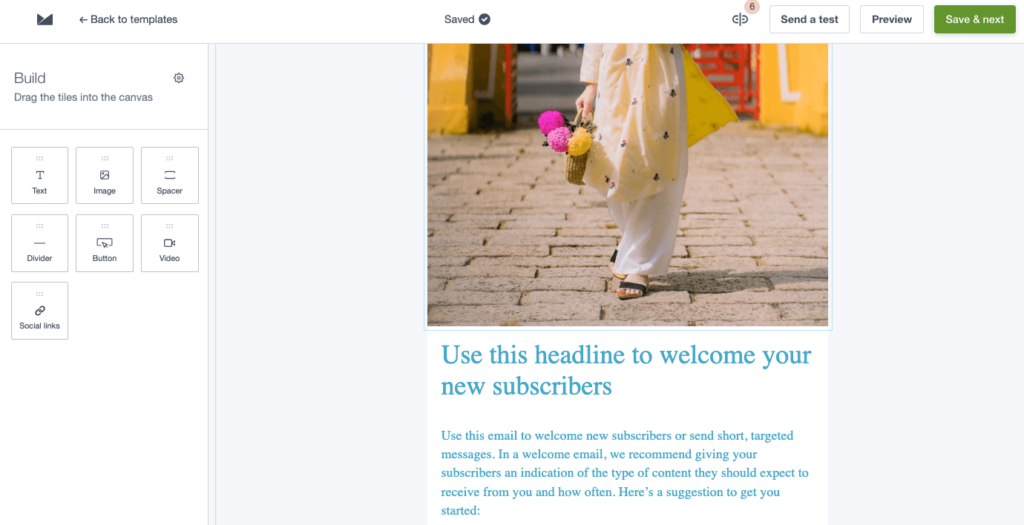
When it’s email templates in question, Campaign Monitor stands out. It comes with 120 templates for various occasions and needs.
Mailchimp is no less, though. The tool comes with modern-looking templates and blank templates called ‘layouts’ for those who want more control.
Now, let’s look at other features, such as auto branding addition and personalization.
– Personalization tags to dynamically populate recipient-specific information such as name and location
– Merge tags for personalized subject lines
– Dynamic content blocks for personalized imagery and offers
– Dynamic content blocks, merge tags, conditional content
– A bit difficult to use without Knowledge Base
– Yes, very straightforward
– Very easy, but removing the Mailchimp tag from emails is complex
– Ability to lock sections of the template giving you control over what your team can update
– Three email templates that are built automatically using your brand style from the store
– Image library with a wide variety of free images
– Ability to send postcards, create surveys, and get subject line recommendations
– 25 tokens for inbox previews on various devices in integration with Litmus
As you can see, both tools offer great functionalities allowing you to create engaging emails.
However, knowing what the tools are lacking will also play an important role in your decision-making process.
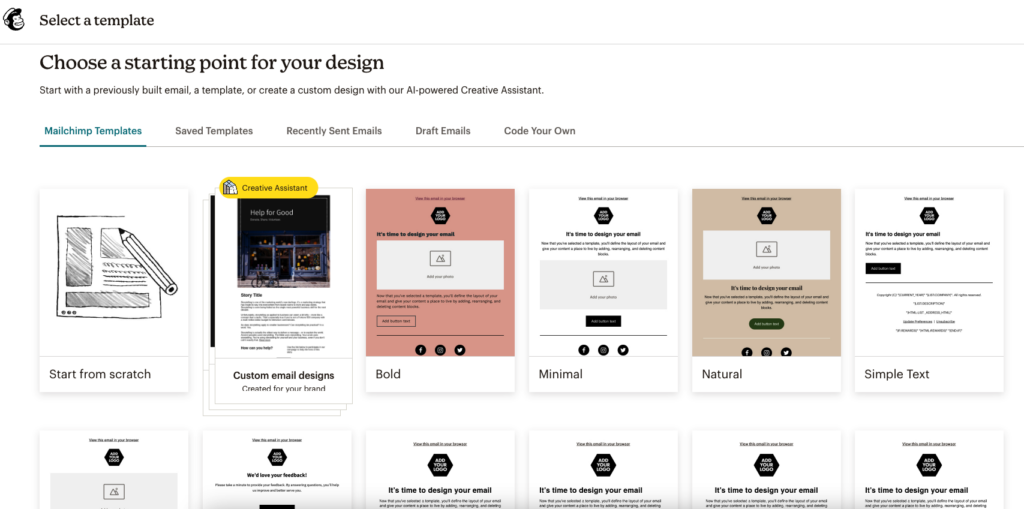
Talking of Mailchimp, you’ll only get access to six basic email templates if you’re a free plan user. As for Campaign Monitor, the email builder is pretty basic. It only features main elements such as image, text, button, divider, and more. No quizzes, timers, and other interactive elements.
Mailchimp emerges as the winner with its new email builder. It is much more advanced, leaving more room for creativity and personalization.
Marketing automation
As your business expands, you’ll find that automation is necessary to manage increasing leads and customers effectively.
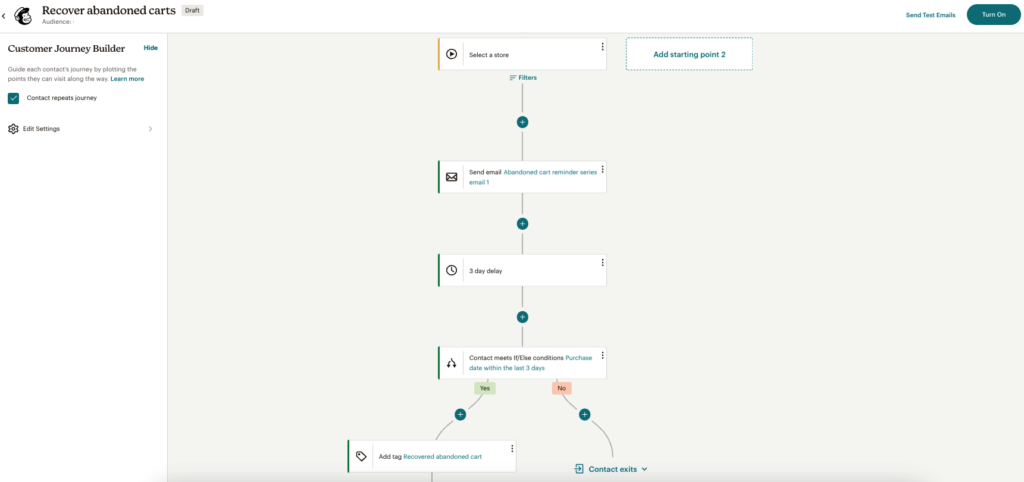
Both tools come with user-friendly automation editors. However, Mailchimp has the edge over Campaign Monitor. Let’s find out why:
- Pre-built workflows: Mailchimp has 70+ pre-built customer journey templates, including different social media channels and emails. The only pre-built workflow Campaign Monitor offers is a welcome email.
- Triggers: With Campaign Monitor, you get a limited list of triggers (subscriber details, custom fields, journey activity). Mailchimp has built-in triggers based on more events and/or actions, including shopping behavior.
- Marketing channels: Mailchimp allows you to integrate other marketing channels, such as SMS, web push notifications, and social media, into your automation workflow. However, it’s important to mention that this can only be achieved through 3rd party integrations. On the other hand, Campaign Monitor limits the automation part to emails only.
- Analytics: Although Campaign Monitor offers analytics for automated journeys, Mailchimp’s capabilities are much more robust. The biggest difference is that on Campaign Monitor there are no ecommerce reports, like revenue or orders generated through email campaigns.
Mailchimp wins this one. It caters to businesses of all sizes, particularly those seeking advanced automation.
Signup forms and landing pages
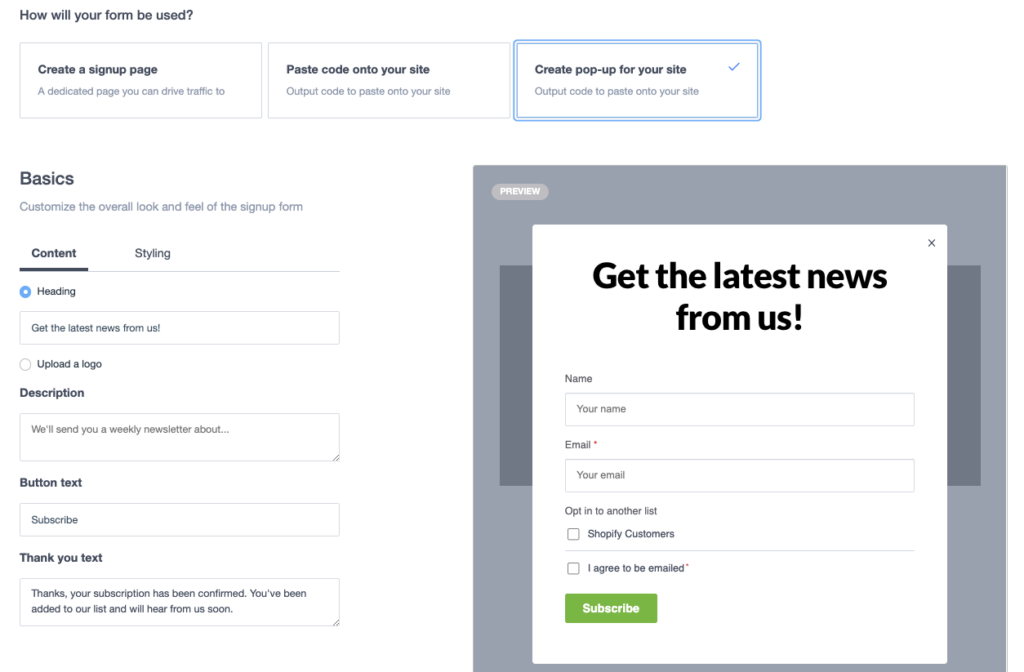
Next, let’s compare Campaign Monitor vs Mailchimp in terms of their list-building capabilities.
There’re many similarities between both tools in this regard. For starters, neither comes with pre-built signup forms.
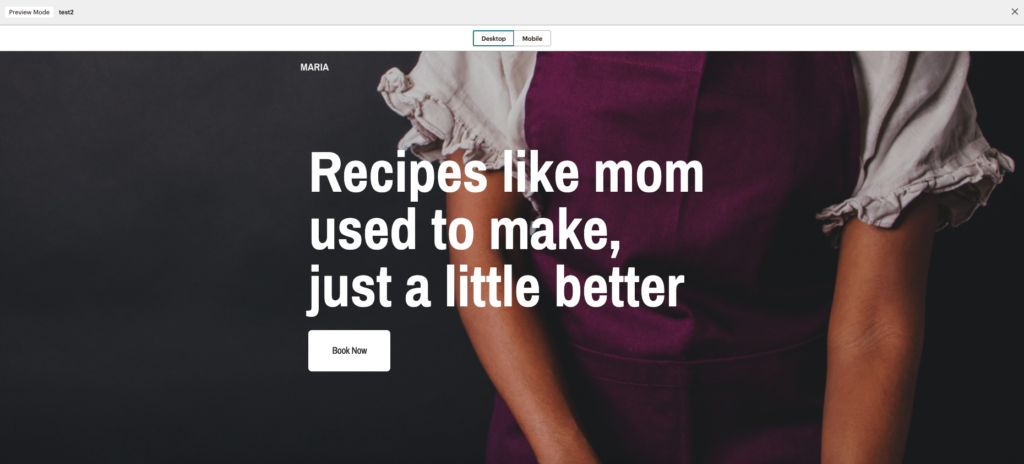 However, there are also crucial differences. For instance, Mailchimp has a comprehensive landing page builder. Campaign Monitor is missing this feature, and the signup page itself works as a landing page.
However, there are also crucial differences. For instance, Mailchimp has a comprehensive landing page builder. Campaign Monitor is missing this feature, and the signup page itself works as a landing page.
That said, let’s compare both tools more intricately:
– One basic form design customizable as per your brand style
– Tricky to find signup forms
– One basic form design customizable as per your brand style
– No, the signup page works as a landing page
– Yes, robust landing page builder and 9 templates
– Can be used to offer exclusive content, discounts, or incentives
– Very straightforward
– Contacts import tool is straightforward to use
– List segmentation is possible, but it’s tricky to find
– Easily tag and segment subscribers
– Lists are siloed; need to pay for duplicate contacts
Mailchimp provides a variety of signup form options, giving you the flexibility to choose from popups, flyouts, inline forms, banners, and more.
In comparison, Campaign Monitor’s options are pretty limited to popup and the signup page.
What’s more, although limited, Mailchimp offers analytics specifically for gauging the performance of signup forms. Campaign Monitor doesn’t.
Mailchimp wins once again. It fares better than Campaign Monitor in most list-building aspects and has a great landing page builder. However, you should keep in mind their not-friendly contact counting policy.
Segmentation
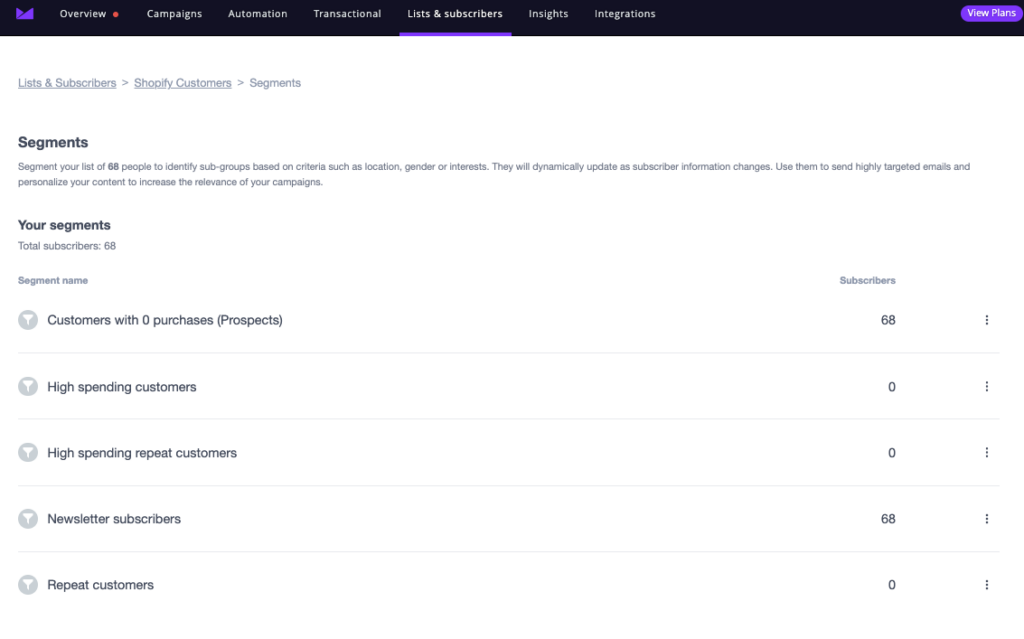
To benefit from Campaign Monitor’s segmentation, you need to be signed up for the Premier plan, starting at a hefty $149 per month. Other paid plans don’t even include basics such as email engagement segments.
In comparison, Mailchimp is a lot more generous. Its low-tier plans offer a lot more possibilities for list segmentation.
The platform’s segmentation tools simplify targeting individuals based on their behavior and interests. It provides three pre-built segments, allowing you to customize each segment by adding up to five conditions.
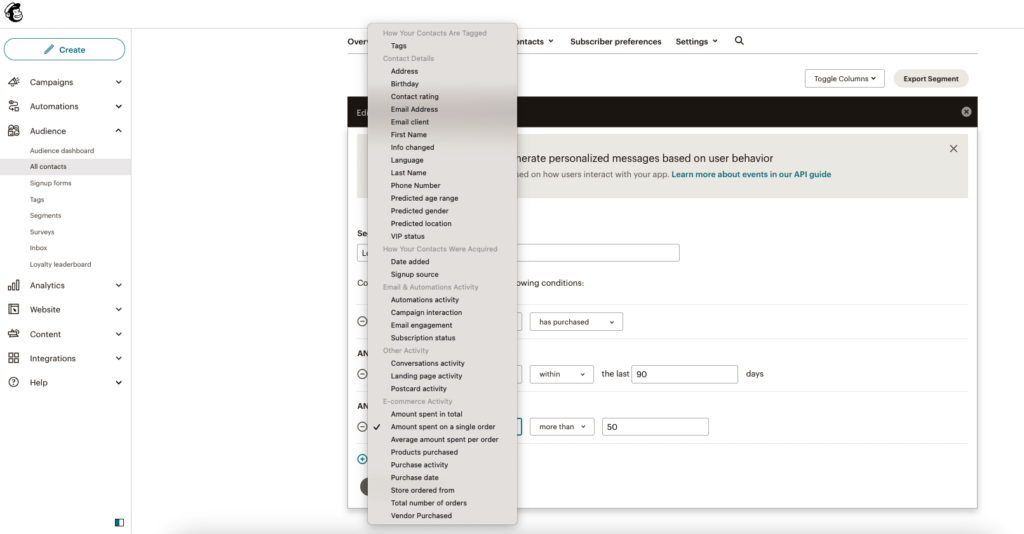
Additionally, if you own an ecommerce business, you can benefit from Mailchimp’s segmentation based on factors such as:
- Purchase history
- Order value
- Specific product categories
Campaign Monitor’s segmentation options are pretty limited and are based on subscriber details and custom fields; such as campaign activity.
Also, one important feature we found missing was segmentation based on purchase behavior.
Mailchimp is the clear winner here. While it may come with a slightly steeper learning curve, Mailchimp offers greater flexibility and a wide range of segmentation options.
Analytics
Mailchimp vs Campaign Monitor, which one offers better analytics and reporting?
Let’s find out.
Mailchimp offers lots of tools to enable you to track the performance of your ecommerce marketing efforts effectively. These include:
- Dashboard: Mailchimp’s analytics dashboard presents data on crucial metrics concerning email performance, audience insights, and ecommerce activity. It also contains list-wide or campaign-specific graphs.
- Heat maps: By analyzing heat maps, you gain insights into effective CTA placement, high-performing links, and overall campaign effectiveness.
- Content Optimizer: This tool offers recommendations based on best industry practices.
- Comparative reporting: Select multiple campaigns for comparison to identify patterns in subscriber engagement and target your campaign content more effectively.
Campaign Monitor, on the other hand, only comes with basic email campaign analytics. It covers metrics such as opens, clicks, delivery rate, bounces, devices, location, etc.
There are absolutely no reporting features for ecommerce businesses. Moreover, it doesn’t offer advanced features like Mailchimp does. These include comparative analysis, multivariate testing, and the ability to export contact activity data for a certain period.
However, these advanced features are only available on Mailchimp’s higher-tiered plans.
Mailchimp is the winner here as this platform provides more comprehensive and detailed insights.
Customer support
Having access to a strong customer support team means that you can receive assistance every time you’re stuck.
Both tools offer support via multiple channels, but there are notable differences in the same:
– 24/7 across all paid plans
– Priority support on the Unlimited plan and premier support on the Premier plan
– Round-the-clock support on all paid plans
– Support for the initial 30 days for free plan users
– Available to Premier plan users
– Available to Premium plan users on weekdays
– Unavailable
– Available on paid plans 24/7
– Email Academy (free learning platform)
– Help Center
– Blog
– Webinars
– Mailchimp 101 tutorials
– Blog
– Marketing Library
– YouTube videos and tutorials in different languages
In addition, Mailchimp also offers personalized onboarding sessions for high-tier plan users.
Mailchimp gains a slight advantage with its highly detailed articles and tutorials, plus live chat support.
Integrations
To achieve optimal results, you can’t rely on an email marketing tool in isolation.
In this segment of the Campaign Monitor vs Mailchimp comparison, we’ll examine the number and types of integrations each platform offers.
Whereas Campaign Monitor offers 100+ integrations, Mailchimp provides more than 300. These fall under different categories such as:
- Ecommerce platforms
- CRM software
- Review platforms
- List building tools
- And more
When it comes to integration with ecommerce platforms, both tools integrate with platforms like Shopify, WooCommerce, and HubSpot.
However, we found it a bit odd that Campaign Monitor doesn’t integrate with some of the significant ecommerce tools such as BigCommerce and Wix.
Mailchimp wins this one, too, as it offers more integrations.
Compatibility with other marketing channels
Mailchimp supports the integration of Facebook and Instagram into your marketing strategy and is compatible with Google Analytics and SMS channel.
Campaign Monitor rolled out SMS marketing. However, it doesn’t include this feature in its current pricing plans. You can contact the platform’s sales team and get a quote if interested.
Also, note that, at the moment, this is only available to users based in the United States.
Mailchimp carries the day for the final round as it gives you more channels to engage with your audience.
Price Comparison
Which software is more value for money, Mailchimp or Campaign Monitor?
When selecting email marketing software for your business, price is often crucial. Many companies operate with limited budgets and may not require the most advanced premium tools.
In this section, we’ll conduct a comprehensive analysis of both tools’ pricing plans.
Campaign Monitor doesn’t offer a free plan; you can opt for its 14-day free trial.
In contrast, Mailchimp does provide a free plan. With a cap of 500 contacts and 1,000 monthly emails, it still offers a good range of features. Here are some of the notable ones:
- Basic segmentation
- Audience dashboard
- Surveys and pop-up forms
- Landing pages
- Facebook and Instagram ads
- Basic analytics
- Personalized product recommendations
- Email support for the first 30 days
Once your contact list exceeds 500 subscribers, you’ve got the option to choose from one of Mailchimp’s paid plans.
Now, let’s compare the paid plans of Campaign Monitor and Mailchimp for different numbers of contacts and evaluate whether they justify the investment.
The table below lays down the monthly prices associated with each tool’s paid plans:
As you can see, Campaign Monitor and Mailchimp are very similarly priced. But Mailchimp seems a lot more valuable when considering its features.
If you’ve just 500 subscribers and want access to basic email marketing features and unlimited sending, Campaign Monitor’s Unlimited plan is probably a good choice.
But if you’ve got a small contact list with a greater need for advanced features, consider Mailchimp’s middle-tier plan.
Also, one key difference between both tools is that an unlimited number of users can use Campaign Monitor, irrespective of the plan. As for Mailchimp, this only applies to its highest-tier plan.
Finally, if you’ve occasional email-sending needs, check out Campaign Monitor’s pay-per-campaign billing system. Here, there are no upfront fees or recurring expenses. You only need to make a payment when you send an email. Check out this article about Campaign Monitor pricing structure.
With all that said, compared to many other competitors, the cost of Campaign Monitor and Mailchimp significantly escalates as the number of contacts in your database grows.
Campaign Monitor vs Mailchimp: Which one wins?
Before we announce the ultimate winner, let’s examine this concise comparison table that outlines the features and pricing of Campaign Monitor vs Mailchimp.
3.6
4.5
500 subscribers – $9
1,000 subscribers – $29
5,000 subscribers – $49
10,000 subscribers – $99
50,000 subscribers – $329
500 subscribers – $13
1,000 subscribers – $27
5,000 subscribers – $75
10,000 subscribers – $110
50,000 subscribers – $385
– Paid plans only
– 14-day free trial
– Quite many paid features
– 1,000 email sends/mo
– A few basic email templates
– Email support for 30 days
– Easy to use
– Simple navigation
– Beautiful email templates
– Real-time reporting analytics
– Wide range of features
– Lots of integrations and can be easily integrated into any toolkit
– Extremely user-friendly
– Good reporting and marketing automation
– Lacks ecommerce insights
– No signup form templates
– Price is relatively high for the features offered
– Charges for email duplicates – if you have the same subscriber in two different lists, you pay extra
– Limited free plan
– Paid plans get very expensive as the subscriber list grows
– Basic email templates on the free plan
– Solopreneurs
– Bloggers
– Non-profit organizations
– Solopreneurs
– Startups
– Bloggers
– Non-profit organizations
– Ecommerce businesses
– Ecommerce stores in their active growth stage
Campaign Monitor is an excellent choice for businesses that only want features specific to email marketing. It falls short when you need supporting features such as a landing page builder, compatibility with other marketing channels, and ecommerce-related capabilities.
Moreover, the saying ‘you get what you pay for’ doesn’t hold for Campaign Monitor. The platform’s features don’t justify the high costs associated with it.
Although Mailchimp is costly, you get access to many features, including advanced ones such as detailed analytics and superior marketing automation.
However, both tools lack ecommerce-focused features. If you want to grow your online store, we recommend other alternatives.
Feel free to explore different platforms by signing up for their free plans or trials and make an informed decision based on firsthand experience.
Read full reviews
Related picks for you
Our team strives to be accurate and unbiased in reviewing email tools. However, we recognize that mistakes can happen, and it’s essential for us to stay up to date. If you come across any errors or things that need to be reviewed again, please let us know.





Leave a Reply